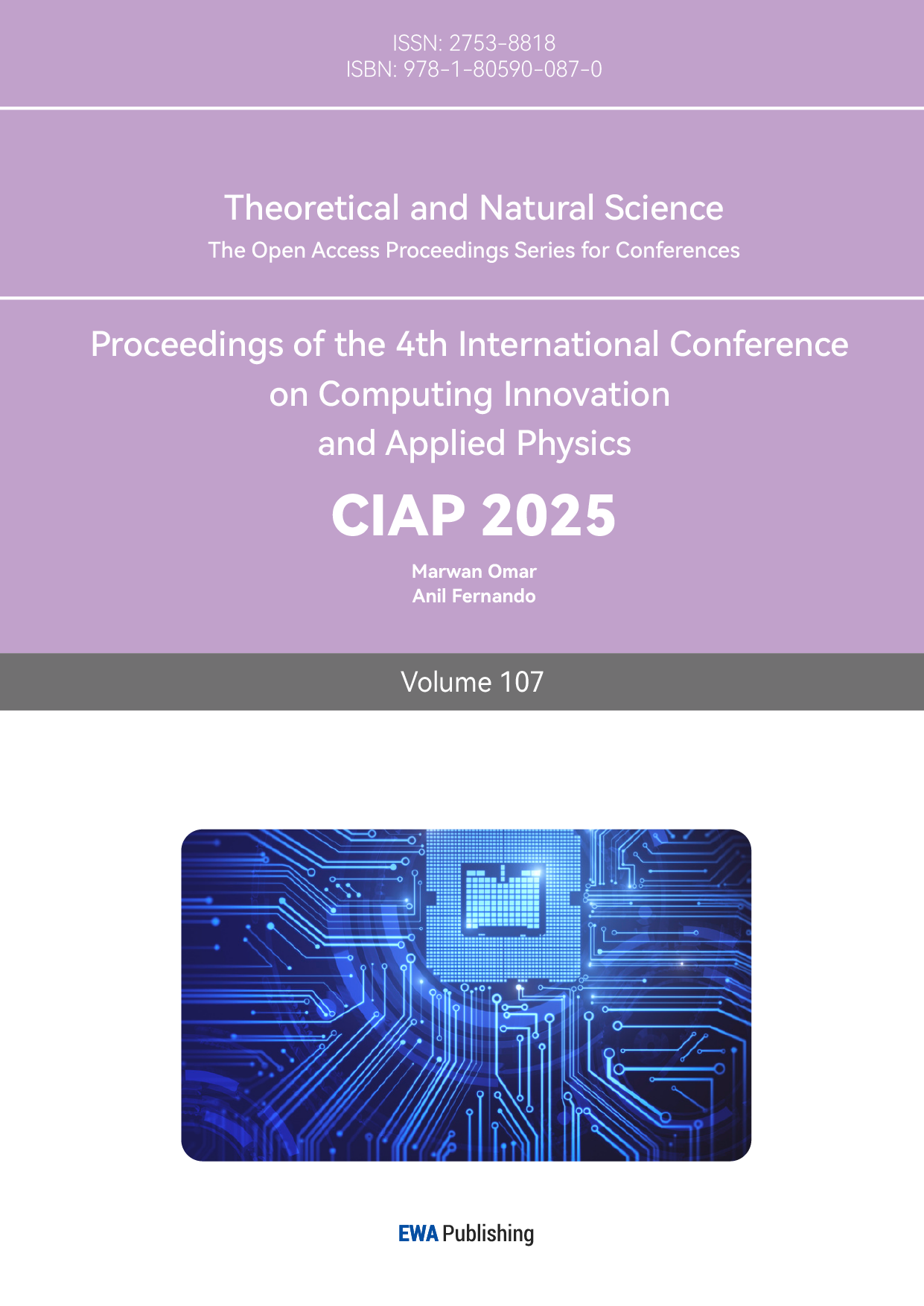1. Introduction
In order to improve the fuel economy of modern cars, advanced materials can be used while maintaining safety and performance. Light materials have great potential to enhance vehicle efficiency. A reduction of 10 percent in the weight of a vehicle has the potential to elevate its fuel efficiency by a range of 6 to 8 percent, resulting in increased mileage and cost savings. Substituting heavy cast iron and conventional steel components with advanced lightweight materials, including magnesium, aluminum, and titanium alloys, holds the promise of slashing the weight of a vehicle's body and chassis by up to half, subsequently diminishing fuel usage and enhancing overall efficiency. [1]. This article focuses on some of the characteristics of these materials, such as their specific strength and fatigue strength, as well as whether different manufacturing processes can improve these properties of materials to achieve the necessary improvements in fuel efficiency.
Aluminum alloy can withstand elastic deformation and impact for vibration and has high specific strength [2]. Some processing techniques in alloys, such as aging treatment, can affect the strength of the alloy. Studies have shown that using re aging (RRA) can decrease the SCC sensitivity of the sample aluminum alloy yet still maintaining a strength level close to T6 tempering [3]. Similarly, aging treatment can also have an impact on fatigue life. Therefore, other studies estimated the fatigue performance of aluminum alloy wheels through fatigue expermentation. This was then compared them with obtained results from finite element analysis [4]. In this paper, we will specifically discuss how aging treatment affects the fatigue performance and strength of aluminum alloys. Magnesium alloy is the lightest known metal material and has a high specific strength [2]. Welding process is usually also a factor affecting the strength of alloys. A study has found that the new welding process Friction Stir Welding (FSW) can improve the strength of magnesium alloy joints [5]. In the study of fatigue life, we found that the surface coating technology of the alloy is correlated to it. There is literature studying the effect of PLA coating (melt deposition 3D printer printed PLA) on AM60 magnesium alloy and its effect on pure alloy, as well as studying fatigue and micro fatigue [6]. In this article, we will discuss in detail the factors that determine a material’s fatigue life and fatigue strength.
People are increasingly using titanium alloys in aerospace, biomedical, and other fields because of their high strength-to-weight ratio [7]. The microstructure of different titanium alloys affects their specific strength. A study has found that the microstructure of the Ti55531 alloy can be improved through electric pulse treatment and step quenching treatment, thereby achieving an improvement in specific strength [8]. For titanium alloys, surface coating processing can affect their fatigue life. Research has found that the fatigue strength of titanium alloys is affected when coatings are applied through laser shock peening pretreatment [9]. In this article, we will discuss in detail the factors that affect the specific strength and fatigue strength of titanium alloys.
In this paper, we will achieve the following goals:
1. Discuss how ageing treatment of aluminium alloy affects its strength [3]. Moreover, the lifespan of aluminium alloy wheels under radial fatigue stress can be predicted through rigorous experimentation, enabling estimation of their endurance against such loads. [4].
2. The Effect of Friction Stir Welding (FSW) on the Strength of Magnesium Alloy Joints [5]. And the influence of PLA coating technology in the study of fatigue life [6].
3. The influence of electric pulse treatment and step quenching treatment on the specific strength of titanium alloys [8]. And how surface coating treatment affects its fatigue life [9].
In addition, we will focus on the impact of improving the specific strength and fatigue performance of alloy materials in the article on automotive fuel efficiency.
2. Discussion
2.1. Aluminium alloys
Aluminum, as a metal, can change its mechanical and physical properties by combining with elements such as copper and magnesium. In order to attain the desired performance for a specific application, they are incorporated in precise ratios or concentrations. For example, combining aluminium with magnesium can create a stable and lightweight alloy, commonly used in aerospace [10] and automotive industries [11]. Aluminium alloy has the characteristics of low density [12], corrosion resistance [13], and thermal conductivity [14]. There are many things made of aluminium alloy, including electronic products, cars, and aeroplanes.
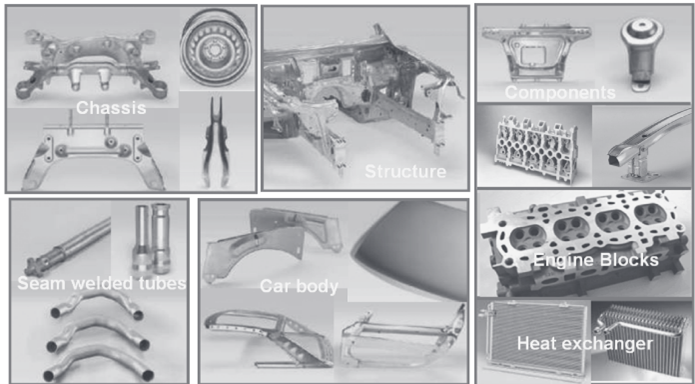
Figure 1: Aluminium products for advanced automotive applications [15]
When conducting research on the specific strength of aluminium alloys, after consulting many literature, a pivotal research inquiry revolves around how Retrogression and Reaging (RRA) affects the strength properties and Stress Corrosion Cracking (SCC) resilience of AA7050 and AA7150 alloys.The corresponding solution is a technique called Regression and Reaging (RRA) has been suggested to decrease the SCC sensitivity of 7XXX alloy while maintaining a strength level close to T6 tempering. The specific method is the samples of extruded profiles were subjected to solution heat treatment under their initial conditions and aged. Afterwards, perform 5, 10, 20, and 40 minutes of regression at 200°C, and then age again at 120°C for 1440 minutes. Tensile and SCC tests were compared with the findings of the alloy under the initial conditions [3]. A further research query explores the methods to quantitatively assess the enhancement of strength within the semi-solid region during the solidification process of two industrially utilized AlpSi alloys, namely AlSi7Mg and AlSi1Mg, in addition to an AICu4 alloy and an AlMgSi alloy, focusing on the paste-like stage. The solution is to use the blade method to quantitatively measure the strength development of the paste-like region during solidification in certain alloys like AlpSi and AlSi7Mg. The designated approach involves employing four blades to quantify the rupture strength of the dendritic microstructure during the solidification phase. Use four different sizes of blades to improve measurement. The development of strength can be determined by analyzing many points (temperature or solid fraction) throughout the solidification range [16].
The conclusion drawn from the aforementioned research inquiry reveals that subsequent to the completion of Retrogression and Reaging (RRA) treatment, the AA7050 alloy exhibits a notable enhancement of 30% in its yield strength. When these two alloys regress for 40 minutes in RRA, their SCC performance did not demonstrate significant changes. Yet, a decay time significantly reduced the performance of SCC. At the same time, research and discussion were conducted: In this work, it was observed that AA7150 exhibits slight differences in SCC performance (40 minutes of regression) compared to the optimal RRA conditions of the alloy under its original T77511 conditions. However, if the loss of elongation is related to fracture toughness, it can be observed that the overall performance of the sample is better under the original conditions [3]. The results of the latter research question indicate the presence or absence of dendritic coherence affecting material strength. The grain refinement of AlSi7Mg and AlCu4 alloys delays the development of strength, while the grain refinement of AlCu4 leads to a slow increase in strength. Adding Sr to AlSi7Mg alloy can slow the development of dendrite coherence and strength. It was observed that with time, the strength reverted back to levels comparable to those of the original, unmodified alloy. The strength development of AlSillMg alloy is very slow. The findings suggest a correlation between this phenomenon and the dimensions as well as the shape and structure of the expanding dendritic formations. A common feature of all alloys was discussed, which is that strength only develops when a certain solid fraction (corresponding to the dendrite phase coherence point) is reached. There is no strength before the dendrite coherence. The alloy composition and grain size both affect the development of strength [16].
When we research fatigue life, one of the research questions focuses on how to achieve lightweight and high-rigidity structures when the cylinder head is used for high combustion. At this point, we can conduct thermal fatigue tests on A356 aluminium alloy (Al-Si Mg series) as the main head material. Subject A356 to ageing treatment, and subsequently observe the effects of artificial ageing under varying conditions subsequent to undergoing the T6 heat treatment process. [17]. An alternative research inquiry revolves around the methodology for deriving S-N curves for A356.2-T6 aluminium alloy and forecasting its fatigue lifespan under radial fatigue stress conditions. The corresponding solution is to conduct fatigue life assessment tests on alloyed wheels. FEA was also used to mimic experimental setups, enabling an in-depth examination of stress distribution patterns and the assessment of fatigue life expectancy in alloy wheels. The specific method is to conduct radial fatigue tests and steering fatigue tests. Implement radial fatigue loading tests aimed at predicting the fatigue lifespan of aluminium alloy wheels, subsequently comparing these estimates with the outcomes derived from finite element analysis simulations. [18].
Our result for the former research problem is that the fatigue life increases with the decrease of strain range and the extension of ageing time. When the ageing time is set, the thermal fatigue life is greatly improved.Extensive research and discussions have uncovered the profound impact of the ageing process subsequent to T6 treatment on significantly enhancing the fatigue life of the material. The ageing time is very effective in determining the rate of change of stress amplitude at the ring end, forming a clear relationship with the material’s durability life [17]. The result of the latter research question is that for a safety factor of 1, changing the circumference angle from 40 to 90 has a much greater impact on the lifespan of the wheel. For a safety factor of 1.5 and a circumferential angle change from 40 to 90, its lifespan is greater than the experimental results. This led to a conclusion: the crack initiation positions from the conducted experiments and FEA were the same. Extensive investigation into various parameters has led to the formulation of safety margins for both fatigue longevity and radial stress loads [18].
2.2. Magnesium alloys
Magnesium is a new material being investigated for use in the car industry, Firstly, the density of this material is quite low, which is only 1.74g/cm3, therefore, “its weight can reduce 15%~20%.” Compared to low carbon steel whose density is commonly 7.6g/cm3 [19]. Due to this fact, many car manufacturers combined this material with other metals, especially Iron, which form different kinds of magnesium alloy. In addition, it also has higher strength and stiffness, which is higher than aluminum and steel, to be specific, the magnesium alloy’s rigidity is almost 10 times more than plastic under the same shape [19]. “Magnesium alloy is an advantageous material to absorb the vibration energy”, double that of steel [19]. There are various kinds of magnesium alloys, which can be used in different parts of car manufacturing. The specific data will be shown in Table 1 below, the different materials used in different parts of the cars are shown in [19, Tab. 1].
Table 1: The table about different materials used in different parts of the car [19]
Category | Part Names | Magnesium alloy Material |
Power System | Hood/Cam Cover, Gear Housing, Clutch housing, Intake Manifold, Oil Pan, Motor Bracket, Oil Filter Connector, ENG Housing, Crankcase Cover/4WD Transfer Case, Gearbox/Gearbox Cover, Oil Pump Box | AZ91, AE42, AS41, AZ81 |
Interior Parts | Dashboard/Gusset Bracket (Common), Steering Column Parts (Common), Seat Frame/Seat Chassis (Common), Steering Wheel (Common), the Seat Lifter, Console Racks, Airbag Cover, Radio Cover, Locking Means Cover, Toolbox Door, Window Glass Motor Cover, Knee Pads Locator | AM50, AM60 |
Body Parts | Door Frames/Door Interior Frames, Tail Plate, Roof Boxes Roof Panel, Sunroof, Mirror Frame, Door Handles, Fuel Cap | AZ31 |
Chassis parts | Wheels, ABC Holder, Brake Pedal Bracket, Brake/Accelerator Support, Brake/Clutch Bracket, Brake Pedal Arm | AZ31 |
Fatigue life is an important indicator of the durability of the material. The magnesium alloy is brittle because the crack can form easily on the surface. The samples that cover PLA material exceed the fatigue life of conventional AM60 because they can resist the time that cracks are produced. The crack is harmful to the material because the brittle fracture can happen unpredictably below 40% of the maximum stress many aeroplane disasters can be attributed to this sudden break of the alloy. This kind of material also hinders the fretting pad from approaching the alloy, increasing the durability of the material. In both pure and fretting fatigue conditions, PLA coating was found to have reduced the number of cracks in samples. Additionally, PLA coating enhances the samples’ fretting fatigue life greatly, ranging from 56% to 2182% [6].
As for the specific strength of the magnesium alloy, this research will concentrate on TMAZ, or the thermo-mechanically affected zone. It is the weakest part in the joint of magnesium alloy-AZ61 using fiction-stir welding (FSW) because the welding efficiency and ductility are unsatisfactory. Therefore, engineers found many useful ways to solve this problem. Firstly, ageing and pre-strain treatment was done on the weld seam to decrase plastic deformation. As a consequence, the new welding efficiency can attain 96% and the new ductility can reach 20%, These new methods are called -0FSW-AG-T3 [5].
This excellent appearance can be shown in the graph from Figure 2. The yield strength(YS), ultimate tensile strength (UTS), and fracture elongation (FE) of the base metal (BE), (FSW), and (FSW-AG-T3) are shown in [5, Fig. 2]. It was found that yield strength (YS), Ultimate tensile strength (UTS, which is defined as the highest amount of stress that can be applied before the material fails), Fracture elongation (FE, the percentage increase in length a material will achieve before breaking) increase simultaneously. The material’s yield strength increased by 20%, and FE increased by 15% to be exact. Welding efficiency can be found by dividing UTS of the joint over the UTS of the base. The welding efficiency of different alloys is shown in [5, Fig. 3], where we found the magnesium alloy of the highest efficiency, increasing from 83% (FSW) to 96% (FSW-AG-T3).
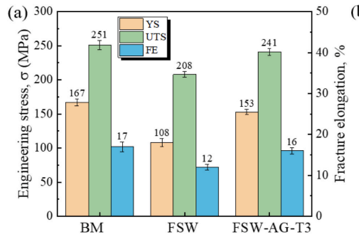
Figure 2: Yield strength (YS), ultimate tensile strength (UTS), fracture elongation (FE) of the magnesium alloy [5]
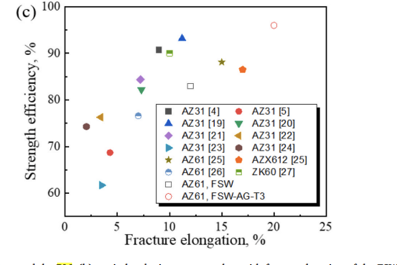
Figure 3: The welding efficiency of different kinds of alloy [5]
2.3. Titanium alloys
Titanium alloys are combinations of titanium and other elements such as aluminium, iron, vanadium, etc [20]. Different grades of titanium alloys can have different material properties, but they are generally known for having high tensile strength, corrosion resistance, and temperature resistance [20]. Some of its applications include aerospace, automotive and dentistry. The information in [20, Tab. 2] shows specific titanium alloys used in the automotive industry [20]. Pure titanium has a density of around 4.5g/cm3 [21]. Structural phases are the different ways an allotropic element’s atoms are organised. Titanium has two main structural phases, α and β. Generally, phase α alloys are stronger but less ductile. On the other hand, phase b alloys are more ductile but have lower strength. Due to this tradeoff, titanium is often alloyed so that the advantages of both α and β phases coexist. In turn, the alloy will have high strength and formability [22]. Maintaining both properties allows the material to resist large forces while not breaking, improving the vehicle’s fuel efficiency and safety if the material is adopted.
Table 2: Automotive applications of titanium alloys [20]
Component | Material | Manufacturer | Model |
Connecting rods | Ti-3Al-2V-rare earth | Honda | Acura NSX |
Connecting rods | Ti-6A1-4V | Ferarri | All 12-cyl |
Wheel rim screws | Ti-6A1-4V | Porsche | Sport wheel option |
Brake pad guide pins | Ti grade 2 | Daimler | S-Class |
Brake sealing washers | Ti grade 1 s | Volkswagen | All |
Specific strength refers to a material’s strength-to-weight ratio. High specific strength is important in an automotive application as vehicles will be more fuel-saving. If a vehicle is manufactured from materials with a higher strength to weight ratio, its weight can be reduced while maintaining the same structural strength. There is a limited understanding of how optimized titanium alloy lattice structures can affect its specific compression strength. A solution to this is to create samples of lattice structures with varying aspect ratios (length over diameter of struts within the structure) through the use of Selective Laser Melting (SLM) manufacturing technology [23]. Examples of the lattice structure’s unit cell, complete structure, and optimised structure are shown in [23, Fig. 4]. The SLM process can machine materials with complex internal structures. It can also fabricate materials with ultrafine, metastable microstructures, improving the material’s yield strength compared to wrought titanium alloys. Lattice materials with different aspect ratios were designed in SolidWorks and manufactured by SLM equipment. Samples were then tested on a compression testing machine [23]. Furthermore, the strength-ductility tradeoff is another common issue that exists when improving titanium alloys’ specific strength in general. Researchers have targeted this problem by preparing a gradient microstructure on a titanium alloy through Electro-Pulsing Treatment (EPT) and Step-Quench Treatment (SQT) [8]. Then, the Ti55531 samples after EPT and SQT went under uniaxial tensile and loading-unloading-reloading tests to record the changes in strength and ductility [8]. An Improvement in both material properties can maintain the vehicle’s structural integrity while also resist impact.

Figure 4: Unit cell, complete structure, optimised structure [23]
Results have shown that when the density of the created lattice structures was 1.81g/cm3, the specific strength was around 326.6MPa/g/cm3. This lead to the sample having a 1.7 times higher strength-to-weight ratio compared to the untreated material [23]. The higher specific strength can be attributed to the lattice structure’s solid struts and its ability to bear higher axial loads [23]. It was also shown that the Ti55531 titanium alloy treated by EPT+SQT (GMES) recorded improvements in both strength and formality, reaching an ultimate tensile strength of 1280MPa and ductility at 12.6% of elongation [8]. In fact, as shown in [8, Fig. 5], GMES recorded higher strength than the titanium alloy with a Gradient Microstructure by EPT (GME) only [8]. The axial gradient microstructure successively overcomes the strength-ductility tradeoff issue, improving the strength of the alloy without any compromise in ductility [8]. Since the processes mentioned above have limited effect on the material’s mass, the improvement in the material’s strength also corresponds to an improvement in specific strength. The improvement in specific strength of such titanium alloys is important as it enhances the vehicle’s fuel efficiency. This is because the vehicle would be under less load while maintaining the same structural strength, requiring less fuel to travel the same distance.
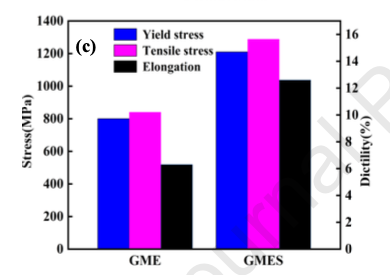
Figure 5: GMES improvement in strength and ductility compared to GME [8]
Fatigue performance, is the measurement of how well a material can withstand load. This includes fatigue strength, which is the highest stress a material is able to endure without failure for infinite cycles of load [24]; and fatigue life, the maximum cycles a material can withstand a given load before failure [25]. High fatigue strength and fatigue life improves the safety of the vehicle, since the car would be able to endure a higher load for an extended period. The fatigue strength of titanium alloys is often compromised when a coating is applied to improve their solid particle erosion resistance. One solution to this is the application of a coating through Laser Shock Peening (LSP) pre-treatment. The physical process of LSP pre-treatment is shown in [26, Fig. 6]. The solution was tested by comparing the result of LSP on a Ti-6Al-4V sample’s fatigue strength against two other samples, one coated without LSP and one not coated at all. Fatigue tests were performed on an electromagnetic vibration test platform, which will load samples with incrementally higher stress levels until their failure [26]. Another issue with improving titanium alloys’ fatigue resistance is maintaining the material’s surface integrity when under high-energy surface strengthening. The solution is to use a surface pre-strengthening-EPT method that first induces a surface strengthening layer followed by electron-pulsing treatment. To test the effect of the solution, fatigue examinations were performed on a high-frequency fatigue instrument [9]. After shot peening and EPT, the titanium alloy sample were compared to two other samples: the alloy without treatment and the alloy strengthened through shot peening only [9].
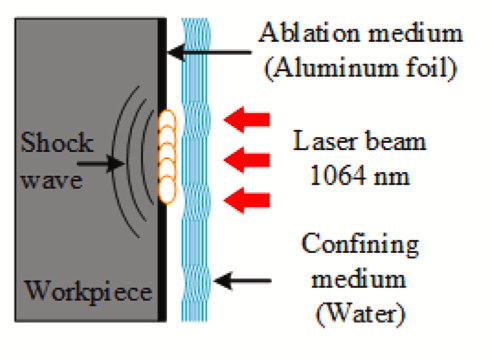
Figure 6: LSP physical process [26]
Test results from the first problem presented the average fatigue strength of the titanium alloy coated under LSP pre-treatment as 499.1MPa, 25.8% higher than the sample coated without the LSP process and 98.8% higher than the sample with no coating at all. This was because the LSP pre-treatment layered a hardened surface with improved compressive strength, demonstrating LSP’s effectiveness in improving the titanium alloys' fatigue strength [26]. Test results from the second issue show that EPT has improved the fatigue life of LSP samples by almost 60%. This is exemplified in the graph of [9, Fig. 7]. The durability life was extended because EPT stabilised the microstructure of the surface layer and delayed the development of cracks [9]. The improvement in fatigue strength and fatigue life of titanium alloys as recorded from research collected above, if adopted into the automotive industry, will enhance a vehicle’s safety, as the vehicle can safely withstand and sustain higher loads for longer periods.
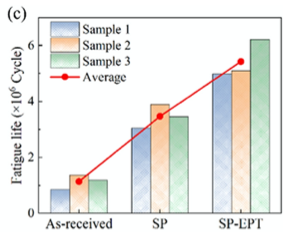
Figure 7: Improvement in fatigue life for all samples [9]
3. Conclusion
This study reviews and compares the material properties of aluminium alloys, magnesium alloys, and titanium alloys. The effect of new fabrication techniques on the materials’ specific strength and fatigue performance was considered to evaluate their impact on vehicle performance. Specifically, vehicles manufactured from such materials will exhibit positive results in fuel efficiency and safety.
Specific Strength
• The specific strength of AA7050 alloy increased by 30% after RRA treatment [3]. Furthermore, grain refinement of the AlCu4 alloy improved its specific strength [16].
• The magnesium alloy sample’s specific strength after Friction Stir Welding (FSW) was enhanced by 20% along with improvements in the material’s ductility [5].
• The Ti55531 lattice sample had a 1.7 times higher strength-to-weight ratio compared to the untreated material [23]. The microstructure of the material prepared through EPT and SQT also demonstrated the material’s improvements in both specific strength and ductility [8].
Table 3: Specific strength comparison between aluminium alloys, magnesium alloys, and titanium alloys
Aluminium Alloys | Magnesium Alloys | Titanium Alloys | |
Ultimate Tensile Stress (MPa) | 625 MPa | 241 MPa | 1280 MPa |
Density (g/cm3) | 2.71 g/cm3 | 1.74 g/cm3 | 4.50 g/cm3 |
Specific Strength (MPa×cm3/g) | 231 MPa×cm3/g | 139 MPa×cm3/g | 284 MPa×cm3/g |
Fatigue Performance
• Extending the time of ageing treatment enhances the fatigue performance of aluminium alloys [17]. The simulated fatigue life of aluminium alloy wheels corresponded to experimental results as well. [18].
• PLA coating applied onto magnesium alloys can enhance the material’s fatigue life significantly [6].
• The fatigue strength of titanium alloys improves when a coating is applied through LSP pre-treatment [26]. The durability of titanium alloys can also be enhanced by coating a surface strengthening layer on the material, followed by Electron-Pulsing Treatment [9].
According to calculations in Table 3, the specific strength of titanium alloys was found to be the highest in this study. Therefore, the vehicle assembled from titanium alloys would be more fuel efficient in theory and is thus recommended to have more researchers to investigate. It is important to note that the specific strength calculations in Table 3 were made assuming no change in mass during fabrication. Unfortunately, fatigue performance was more difficult to compare across the selected materials as different testing methods were employed during such studies. However, it can be said that the material with a higher specific strength can also improve the vehicle’s safety indirectly. If specific strength is improved, the vehicle can then be assembled from a larger quantity of such material to improve its strength while maintaining the same weight, enhancing the vehicle’s safety performance.
References
[1]. G. Refiadi, I. S. Aisyah, and J. P. Siregar, “Trends in Lightweight Automotive Materials for Improving Fuel Efficiency and Reducing Carbon Emissions,” Automot. Exp., vol. 2, no. 3, pp. 78–90, Oct. 2019, doi: 10.31603/ae.v2i3.2984.
[2]. D. Haber, “Lightweight Materials for Automotive Applications: A Review,” presented at the 24th SAE Brasil International Congress and Display, Sep. 2015, pp. 2015-36–0219. doi: 10.4271/2015-36-0219.
[3]. A. F. Oliveira, M. C. De Barros, K. R. Cardoso, and D. N. Travessa, “The effect of RRA on the strength and SCC resistance on AA7050 and AA7150 aluminium alloys,” Mater. Sci. Eng. A, vol. 379, no. 1–2, pp. 321–326, Aug. 2004, doi: 10.1016/j.msea.2004.02.052.
[4]. P. R. Raju, B. Satyanarayana, K. Ramji, and K. S. Babu, “Evaluation of fatigue life of aluminum alloy wheels under radial loads,” Eng. Fail. Anal., vol. 14, no. 5, pp. 791–800, Jul. 2007, doi: 10.1016/j.engfailanal.2006.11.028.
[5]. N. Xu et al., “Enhanced mechanical properties of thermo-mechanically affected zone of friction-stir welded AZ61 magnesium alloy joint,” J. Mater. Res. Technol., vol. 30, pp. 3594–3601, May 2024, doi: 10.1016/j.jmrt.2024.04.098.
[6]. S. Rezanezhad and M. Azadi, “The influence of 3D-printed PLA coatings on pure and fretting fatigue properties of AM60 magnesium alloys under cyclic bending loads,” Heliyon, vol. 10, no. 8, p. e29552, Apr. 2024, doi: 10.1016/j.heliyon.2024.e29552.
[7]. C. Veiga, J. P. Davim, and A. Loureiro, “Properties and applications of titanium alloys: A brief review,” Rev. Adv. Mater. Sci., vol. 32, pp. 133–148, Dec. 2012.
[8]. C. Tan et al., “Enhanced strength–ductility synergy in Ti55531 titanium alloys through gradient microstructural design strategy,” Mater. Sci. Eng. A, p. 146823, Jun. 2024, doi: 10.1016/j.msea.2024.146823.
[9]. X. Ren, Z. Wang, and R. An, “A promising approach to enhance fatigue life of TC11 titanium alloy: Low dislocation density and surface grain refinement induced by electropulsing,” J. Mater. Sci. Technol., vol. 204, pp. 60–70, Apr. 2024, doi: 10.1016/j.jmst.2024.03.020.
[10]. Z. Huda, N. I. Taib, and T. Zaharinie, “Characterization of 2024-T3: An aerospace aluminum alloy,” Mater. Chem. Phys., vol. 113, no. 2–3, pp. 515–517, Feb. 2009, doi: 10.1016/j.matchemphys.2008.09.050.
[11]. A. H. Musfirah and J. Ghani, “Magnesium and aluminum alloys in automotive industry,” J. Appl. Sci. Res., vol. 8, pp. 4865–4875, Jan. 2012.
[12]. S. J. Yan et al., “Investigating aluminum alloy reinforced by graphene nanoflakes,” Mater. Sci. Eng. A, vol. 612, pp. 440–444, Aug. 2014, doi: 10.1016/j.msea.2014.06.077.
[13]. H. Ezuber, A. El-Houd, and F. El-Shawesh, “A study on the corrosion behavior of aluminum alloys in seawater,” Mater. Des., vol. 29, no. 4, pp. 801–805, Jan. 2008, doi: 10.1016/j.matdes.2007.01.021.
[14]. R. Brandt and G. Neuer, “Electrical Resistivity and Thermal Conductivity of Pure Aluminum and Aluminum Alloys up to and above the Melting Temperature,” Int. J. Thermophys., vol. 28, no. 5, pp. 1429–1446, Nov. 2007, doi: 10.1007/s10765-006-0144-0.
[15]. J. Hirsch, “Aluminium in Innovative Light-Weight Car Design,” Mater. Trans., vol. 52, no. 5, pp. 818–824, 2011, doi: 10.2320/matertrans.L-MZ201132.
[16]. A. K. Dahle and L. Arnberg, “Development of strength in solidifying aluminium alloys,” Acta Mater., vol. 45, no. 2, pp. 547–559, Feb. 1997, doi: 10.1016/S1359-6454(96)00203-0.
[17]. Tsuyoshi-Takahashi and K. Sasaki, “Low cycle thermal fatigue of aluminum alloy cylinder head in consideration of changing metrology microstructure,” Procedia Eng., vol. 2, no. 1, pp. 767–776, Apr. 2010, doi: 10.1016/j.proeng.2010.03.083.
[18]. P. R. Raju, B. Satyanarayana, K. Ramji, and K. S. Babu, “Evaluation of fatigue life of aluminum alloy wheels under radial loads,” Eng. Fail. Anal., vol. 14, no. 5, pp. 791–800, Jul. 2007, doi: 10.1016/j.engfailanal.2006.11.028.
[19]. C. P. Du and D. F. Xu, “Application of Energy-Saving Magnesium Alloy in Automotive Industry,” Adv. Mater. Res., vol. 734–737, pp. 2244–2247, Aug. 2013, doi: 10.4028/www.scientific.net/AMR.734-737.2244.
[20]. A. Jayakumar, S. Radoor, J. Kim, J. Rhim, J. Parameswaranpillai, and S. Siengchin, “Lightweight and sustainable materials—a global scenario,” in Lightweight and Sustainable Composite Materials, S. M. Rangappa, S. M. Doddamani, S. Siengchin, and M. Doddamani, Eds., Woodhead Publishing, 2023, pp. 1–18. doi: 10.1016/B978-0-323-95189-0.00001-9.
[21]. S. Oukach, B. Pateyron, and L. Pawłowski, “Physical and chemical phenomena occurring between solid ceramics and liquid metals and alloys at laser and plasma composite coatings formation: A review,” Surf. Sci. Rep., vol. 74, no. 3, pp. 213–241, Aug. 2019, doi: 10.1016/j.surfrep.2019.06.001.
[22]. M. Srivastava, S. Rathee, V. Patel, A. Kumar, and P. G. Koppad, “A review of various materials for additive manufacturing: Recent trends and processing issues,” J. Mater. Res. Technol., vol. 21, pp. 2612–2641, Nov. 2022, doi: 10.1016/j.jmrt.2022.10.015.
[23]. X. Yang, W. Ma, Z. Zhang, S. Liu, and H. Tang, “Ultra-high specific strength Ti6Al4V alloy lattice material manufactured via selective laser melting,” Mater. Sci. Eng. A, vol. 840, p. 142956, Apr. 2022, doi: 10.1016/j.msea.2022.142956.
[24]. B. K. Parida, “Fatigue Testing,” in Encyclopedia of Materials: Science and Technology, K. H. J. Buschow, R. W. Cahn, M. C. Flemings, B. Ilschner, E. J. Kramer, S. Mahajan, and P. Veyssière, Eds., Oxford: Elsevier, 2001, pp. 2994–2999. doi: 10.1016/B0-08-043152-6/00533-7.
[25]. “Material Interface of Pantograph and Contact Line - ScienceDirect.” Accessed: Jul. 11, 2024. [Online]. Available: https://www.sciencedirect.com/science/article/abs/pii/B9780128128862000057
[26]. X. Cao et al., “Effect of TiN/Ti coating combined with laser shock peening pre-treatment on the fatigue strength of Ti-6Al-4V titanium alloy,” Surf. Coat. Technol., vol. 403, p. 126393, Dec. 2020, doi: 10.1016/j.surfcoat.2020.126393.
Cite this article
Wang,K.;Xu,J.;Zhang,Y. (2025). Custom Material Properties for Automotive Applications. Theoretical and Natural Science,107,14-24.
Data availability
The datasets used and/or analyzed during the current study will be available from the authors upon reasonable request.
Disclaimer/Publisher's Note
The statements, opinions and data contained in all publications are solely those of the individual author(s) and contributor(s) and not of EWA Publishing and/or the editor(s). EWA Publishing and/or the editor(s) disclaim responsibility for any injury to people or property resulting from any ideas, methods, instructions or products referred to in the content.
About volume
Volume title: Proceedings of the 4th International Conference on Computing Innovation and Applied Physics
© 2024 by the author(s). Licensee EWA Publishing, Oxford, UK. This article is an open access article distributed under the terms and
conditions of the Creative Commons Attribution (CC BY) license. Authors who
publish this series agree to the following terms:
1. Authors retain copyright and grant the series right of first publication with the work simultaneously licensed under a Creative Commons
Attribution License that allows others to share the work with an acknowledgment of the work's authorship and initial publication in this
series.
2. Authors are able to enter into separate, additional contractual arrangements for the non-exclusive distribution of the series's published
version of the work (e.g., post it to an institutional repository or publish it in a book), with an acknowledgment of its initial
publication in this series.
3. Authors are permitted and encouraged to post their work online (e.g., in institutional repositories or on their website) prior to and
during the submission process, as it can lead to productive exchanges, as well as earlier and greater citation of published work (See
Open access policy for details).
References
[1]. G. Refiadi, I. S. Aisyah, and J. P. Siregar, “Trends in Lightweight Automotive Materials for Improving Fuel Efficiency and Reducing Carbon Emissions,” Automot. Exp., vol. 2, no. 3, pp. 78–90, Oct. 2019, doi: 10.31603/ae.v2i3.2984.
[2]. D. Haber, “Lightweight Materials for Automotive Applications: A Review,” presented at the 24th SAE Brasil International Congress and Display, Sep. 2015, pp. 2015-36–0219. doi: 10.4271/2015-36-0219.
[3]. A. F. Oliveira, M. C. De Barros, K. R. Cardoso, and D. N. Travessa, “The effect of RRA on the strength and SCC resistance on AA7050 and AA7150 aluminium alloys,” Mater. Sci. Eng. A, vol. 379, no. 1–2, pp. 321–326, Aug. 2004, doi: 10.1016/j.msea.2004.02.052.
[4]. P. R. Raju, B. Satyanarayana, K. Ramji, and K. S. Babu, “Evaluation of fatigue life of aluminum alloy wheels under radial loads,” Eng. Fail. Anal., vol. 14, no. 5, pp. 791–800, Jul. 2007, doi: 10.1016/j.engfailanal.2006.11.028.
[5]. N. Xu et al., “Enhanced mechanical properties of thermo-mechanically affected zone of friction-stir welded AZ61 magnesium alloy joint,” J. Mater. Res. Technol., vol. 30, pp. 3594–3601, May 2024, doi: 10.1016/j.jmrt.2024.04.098.
[6]. S. Rezanezhad and M. Azadi, “The influence of 3D-printed PLA coatings on pure and fretting fatigue properties of AM60 magnesium alloys under cyclic bending loads,” Heliyon, vol. 10, no. 8, p. e29552, Apr. 2024, doi: 10.1016/j.heliyon.2024.e29552.
[7]. C. Veiga, J. P. Davim, and A. Loureiro, “Properties and applications of titanium alloys: A brief review,” Rev. Adv. Mater. Sci., vol. 32, pp. 133–148, Dec. 2012.
[8]. C. Tan et al., “Enhanced strength–ductility synergy in Ti55531 titanium alloys through gradient microstructural design strategy,” Mater. Sci. Eng. A, p. 146823, Jun. 2024, doi: 10.1016/j.msea.2024.146823.
[9]. X. Ren, Z. Wang, and R. An, “A promising approach to enhance fatigue life of TC11 titanium alloy: Low dislocation density and surface grain refinement induced by electropulsing,” J. Mater. Sci. Technol., vol. 204, pp. 60–70, Apr. 2024, doi: 10.1016/j.jmst.2024.03.020.
[10]. Z. Huda, N. I. Taib, and T. Zaharinie, “Characterization of 2024-T3: An aerospace aluminum alloy,” Mater. Chem. Phys., vol. 113, no. 2–3, pp. 515–517, Feb. 2009, doi: 10.1016/j.matchemphys.2008.09.050.
[11]. A. H. Musfirah and J. Ghani, “Magnesium and aluminum alloys in automotive industry,” J. Appl. Sci. Res., vol. 8, pp. 4865–4875, Jan. 2012.
[12]. S. J. Yan et al., “Investigating aluminum alloy reinforced by graphene nanoflakes,” Mater. Sci. Eng. A, vol. 612, pp. 440–444, Aug. 2014, doi: 10.1016/j.msea.2014.06.077.
[13]. H. Ezuber, A. El-Houd, and F. El-Shawesh, “A study on the corrosion behavior of aluminum alloys in seawater,” Mater. Des., vol. 29, no. 4, pp. 801–805, Jan. 2008, doi: 10.1016/j.matdes.2007.01.021.
[14]. R. Brandt and G. Neuer, “Electrical Resistivity and Thermal Conductivity of Pure Aluminum and Aluminum Alloys up to and above the Melting Temperature,” Int. J. Thermophys., vol. 28, no. 5, pp. 1429–1446, Nov. 2007, doi: 10.1007/s10765-006-0144-0.
[15]. J. Hirsch, “Aluminium in Innovative Light-Weight Car Design,” Mater. Trans., vol. 52, no. 5, pp. 818–824, 2011, doi: 10.2320/matertrans.L-MZ201132.
[16]. A. K. Dahle and L. Arnberg, “Development of strength in solidifying aluminium alloys,” Acta Mater., vol. 45, no. 2, pp. 547–559, Feb. 1997, doi: 10.1016/S1359-6454(96)00203-0.
[17]. Tsuyoshi-Takahashi and K. Sasaki, “Low cycle thermal fatigue of aluminum alloy cylinder head in consideration of changing metrology microstructure,” Procedia Eng., vol. 2, no. 1, pp. 767–776, Apr. 2010, doi: 10.1016/j.proeng.2010.03.083.
[18]. P. R. Raju, B. Satyanarayana, K. Ramji, and K. S. Babu, “Evaluation of fatigue life of aluminum alloy wheels under radial loads,” Eng. Fail. Anal., vol. 14, no. 5, pp. 791–800, Jul. 2007, doi: 10.1016/j.engfailanal.2006.11.028.
[19]. C. P. Du and D. F. Xu, “Application of Energy-Saving Magnesium Alloy in Automotive Industry,” Adv. Mater. Res., vol. 734–737, pp. 2244–2247, Aug. 2013, doi: 10.4028/www.scientific.net/AMR.734-737.2244.
[20]. A. Jayakumar, S. Radoor, J. Kim, J. Rhim, J. Parameswaranpillai, and S. Siengchin, “Lightweight and sustainable materials—a global scenario,” in Lightweight and Sustainable Composite Materials, S. M. Rangappa, S. M. Doddamani, S. Siengchin, and M. Doddamani, Eds., Woodhead Publishing, 2023, pp. 1–18. doi: 10.1016/B978-0-323-95189-0.00001-9.
[21]. S. Oukach, B. Pateyron, and L. Pawłowski, “Physical and chemical phenomena occurring between solid ceramics and liquid metals and alloys at laser and plasma composite coatings formation: A review,” Surf. Sci. Rep., vol. 74, no. 3, pp. 213–241, Aug. 2019, doi: 10.1016/j.surfrep.2019.06.001.
[22]. M. Srivastava, S. Rathee, V. Patel, A. Kumar, and P. G. Koppad, “A review of various materials for additive manufacturing: Recent trends and processing issues,” J. Mater. Res. Technol., vol. 21, pp. 2612–2641, Nov. 2022, doi: 10.1016/j.jmrt.2022.10.015.
[23]. X. Yang, W. Ma, Z. Zhang, S. Liu, and H. Tang, “Ultra-high specific strength Ti6Al4V alloy lattice material manufactured via selective laser melting,” Mater. Sci. Eng. A, vol. 840, p. 142956, Apr. 2022, doi: 10.1016/j.msea.2022.142956.
[24]. B. K. Parida, “Fatigue Testing,” in Encyclopedia of Materials: Science and Technology, K. H. J. Buschow, R. W. Cahn, M. C. Flemings, B. Ilschner, E. J. Kramer, S. Mahajan, and P. Veyssière, Eds., Oxford: Elsevier, 2001, pp. 2994–2999. doi: 10.1016/B0-08-043152-6/00533-7.
[25]. “Material Interface of Pantograph and Contact Line - ScienceDirect.” Accessed: Jul. 11, 2024. [Online]. Available: https://www.sciencedirect.com/science/article/abs/pii/B9780128128862000057
[26]. X. Cao et al., “Effect of TiN/Ti coating combined with laser shock peening pre-treatment on the fatigue strength of Ti-6Al-4V titanium alloy,” Surf. Coat. Technol., vol. 403, p. 126393, Dec. 2020, doi: 10.1016/j.surfcoat.2020.126393.





